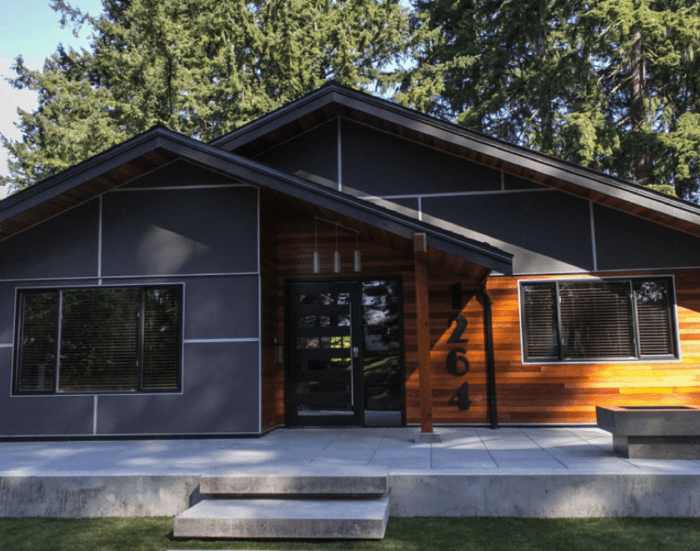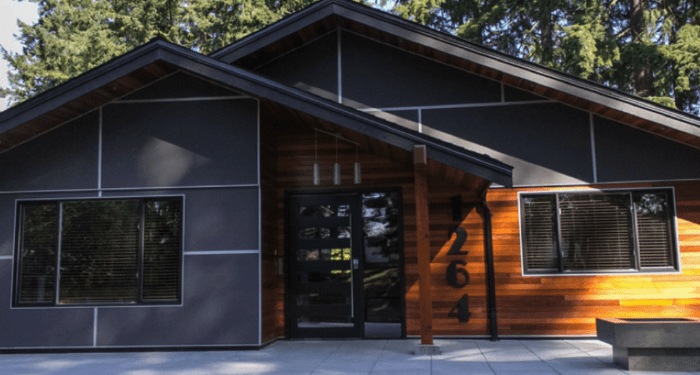As Modern siding ideas for contemporary homes takes center stage, this opening passage beckons readers into a world crafted with good knowledge, ensuring a reading experience that is both absorbing and distinctly original. Let's delve into the realm of modern siding options that can transform the look and functionality of your contemporary home.
From innovative materials to contemporary color trends and sustainable solutions, this guide will equip you with the essential knowledge to elevate your home's exterior aesthetic.
Modern Materials for Siding
When it comes to modern siding for contemporary homes, there are several innovative materials that are commonly used. These materials not only enhance the aesthetic appeal of the house but also offer durability and require minimal maintenance.
Fiber Cement
Fiber cement is a popular choice for modern siding due to its durability and low maintenance requirements. It is resistant to rot, fire, and pests, making it a long-lasting option for homeowners. Additionally, fiber cement siding can mimic the look of wood or stucco, providing a versatile design option for contemporary homes.
Metal
Metal siding, such as steel or aluminum, is another modern material that offers durability and strength. Metal siding is resistant to fire, rot, and pests, making it a low-maintenance option for homeowners. It also comes in a variety of colors and finishes, allowing for a sleek and modern look for contemporary homes.
Wood
Wood siding is a classic choice that has been modernized with new treatment processes to enhance durability. Wood siding offers a natural and warm aesthetic that complements contemporary designs. However, it requires more maintenance compared to other materials to prevent rot and insect damage.
Vinyl
Vinyl siding is a cost-effective and low-maintenance option for modern homes. It comes in a wide range of colors and styles, allowing homeowners to customize their exterior design. Vinyl siding is also resistant to rot, pests, and fading, making it a durable choice for contemporary homes.
Environmental Impact
When considering the environmental impact of siding materials, it is essential to weigh factors such as production processes, longevity, recyclability, and energy efficiency. For example, fiber cement and metal siding have a longer lifespan and can be recycled, reducing their environmental impact compared to wood or vinyl siding.
However, wood siding sourced from sustainable forests can also be an eco-friendly option for environmentally-conscious homeowners.
Contemporary Color Trends
When it comes to contemporary homes, choosing the right colors for siding can make a significant impact on the overall look and feel of the property. From neutral tones to bold contrasts and muted shades, there are various color palettes that are currently trending in modern architecture.
Let's explore some popular contemporary color trends for siding and how they can enhance the aesthetic appeal of your home.
Neutral Tones
Neutral tones such as whites, grays, and beiges are timeless choices for contemporary homes. These colors create a clean and sophisticated look, allowing the architectural details of the home to stand out. Neutral tones are versatile and can complement various design styles, making them a popular choice among homeowners looking for a modern yet classic look.
Bold Contrasts
In contrast to neutral tones, bold contrasts like black, dark blues, or deep greens can add a dramatic flair to contemporary homes. Bold colors create a striking visual impact and can make a bold architectural statement. When paired with lighter accents or trim, bold siding colors can create a dynamic and eye-catching facade that sets your home apart from the rest.
Muted Shades
Muted shades such as soft pastels, earthy tones, and dusty pinks have gained popularity in contemporary architecture. These subtle colors create a calming and inviting atmosphere, perfect for creating a cozy and modern aesthetic. Muted shades are ideal for homeowners looking to add a touch of warmth and personality to their homes without overwhelming the design.
Textures and Finishes

When it comes to modern siding for contemporary homes, textures and finishes play a crucial role in enhancing the overall aesthetic appeal of the facade. Different textures can add depth and visual interest to the exterior, creating a dynamic and engaging look for your home.
Here, we will explore various textures and finishes available for modern siding and how to effectively mix and match them for a cohesive design.
Smooth Textures
- Smooth textures offer a sleek and contemporary appearance, perfect for minimalist and modern architectural styles.
- These textures reflect light evenly, creating a clean and polished look for your home's exterior.
- Smooth textures are easy to clean and maintain, making them a practical choice for busy homeowners.
Matte Finishes
- Matte finishes provide a subtle and understated look, adding a touch of sophistication to your home.
- These finishes are non-reflective, creating a soft and muted appearance that complements various design styles.
- Matte finishes are excellent for hiding imperfections and dirt, maintaining a fresh and flawless facade.
Wood-Grain Textures
- Wood-grain textures mimic the natural look of wood, adding warmth and texture to your home's exterior.
- These textures offer a rustic and organic feel, perfect for blending modern design with traditional elements.
- Wood-grain textures are available in a variety of colors and finishes, allowing you to customize your home's look.
Mixing and Matching Textures
- Combine smooth textures with wood-grain textures for a contemporary yet inviting facade.
- Pair matte finishes with bold colors to create a striking and modern aesthetic for your home.
- Experiment with different textures on different sections of your home to create visual interest and dimension.
Siding Designs for Architectural Styles
When it comes to siding designs for different architectural styles, it's essential to choose options that complement the overall look of the home. From minimalist to mid-century modern and contemporary farmhouse, the siding can play a crucial role in enhancing the architectural features of the house.
Minimalist Architecture
- For minimalist homes, sleek and simple siding designs work best.
- Consider using materials like smooth metal panels or large format porcelain tiles for a clean and understated look.
- Opt for neutral colors like white, grey, or black to maintain the minimalist aesthetic.
Mid-Century Modern Style
- Mid-century modern homes often feature angular lines and large windows.
- Choose siding options like wood panels or vertical board and batten to complement the geometric shapes of the architecture.
- Consider using warm, natural tones like cedar or teak to bring warmth to the exterior.
Contemporary Farmhouse Design
- For contemporary farmhouse styles, mixing traditional and modern siding materials can create a unique look.
- Combine elements like horizontal lap siding with vertical metal panels for a blend of rustic and contemporary aesthetics.
- Choose earthy tones like beige, sage green, or navy blue to complement the farmhouse vibe.
Sustainable Siding Solutions
When it comes to siding options for contemporary homes, sustainability is a key factor to consider. By choosing sustainable siding solutions, you not only reduce your environmental impact but also improve energy efficiency and indoor air quality in your home.
Recycled Materials
One of the most popular sustainable siding options is using recycled materials. These can include reclaimed wood, recycled metal, or even recycled plastic. Not only does this help reduce waste in landfills, but it also gives a unique and eco-friendly look to your home.
Eco-Friendly Finishes
Opting for eco-friendly finishes such as low-VOC paints and stains can further enhance the sustainability of your siding. These finishes emit fewer harmful chemicals into the air, improving indoor air quality and reducing your carbon footprint.
Energy-Efficient Designs
Consider choosing siding designs that are energy-efficient, such as insulated siding. This type of siding helps regulate indoor temperatures, reducing the need for excessive heating or cooling and ultimately lowering energy consumption.
Tips for Choosing Environmentally Friendly Siding
- Look for siding materials that are certified as sustainable by reputable organizations like the Forest Stewardship Council (FSC) or the Cradle to Cradle Products Innovation Institute.
- Consider the longevity and durability of the siding material to minimize the need for frequent replacements, which can be wasteful.
- Consult with a professional contractor who specializes in sustainable building practices to ensure that the siding installation is done in an environmentally friendly manner.
- Explore innovative siding materials like bamboo, cork, or even plant-based fibers for a truly unique and sustainable option.
Last Recap
In conclusion, modern siding ideas offer a myriad of possibilities to enhance the curb appeal and sustainability of contemporary homes. By choosing the right materials, colors, textures, and designs, homeowners can create a visually stunning and eco-friendly facade that stands the test of time.
Dive into the world of modern siding and elevate your home's exterior with style and substance.
Frequently Asked Questions
What are some sustainable siding options for contemporary homes?
Some sustainable siding options include recycled materials, eco-friendly finishes, and energy-efficient designs that not only enhance the look of your home but also contribute to a greener environment.
How do color choices impact the overall look of a home's exterior?
Color choices play a crucial role in setting the tone for a home's exterior. Neutral tones can create a modern and sophisticated look, while bold contrasts can add a dramatic flair. Muted shades offer a subtle and calming aesthetic.
Why is it important to consider siding designs that complement the architectural style of a home?
Harmonizing siding designs with the architectural style of a home enhances its overall aesthetic appeal and can highlight key features of the structure. It creates a cohesive and visually pleasing exterior.




